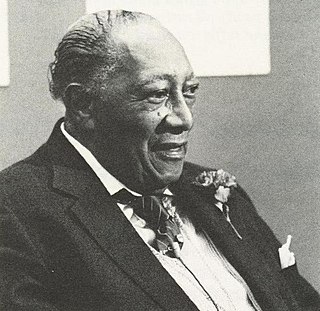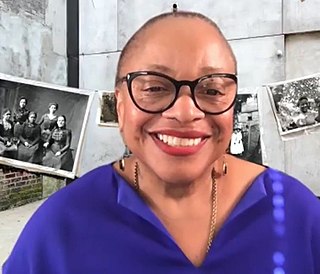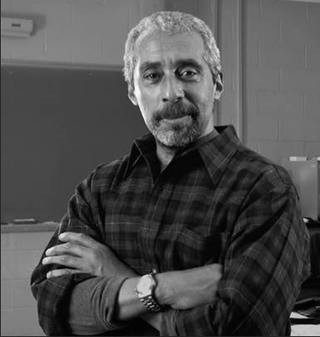Related Research Articles

Renee Cox is a Jamaican-American artist, photographer, lecturer, political activist and curator. Her work is considered part of the feminist art movement in the United States. Among the best known of her provocative works are Queen Nanny of the Maroons, Raje and Yo Mama's Last Supper, which exemplify her Black Feminist politics. In addition, her work has provoked conversations at the intersections of cultural work, activism, gender, and African Studies. As a specialist in film and digital portraiture, Cox uses light, form, digital technology, and her own signature style to capture the identities and beauty within her subjects and herself.

James Augustus Van Der Zee was an American photographer best known for his portraits of black New Yorkers. He was a leading figure in the Harlem Renaissance. Aside from the artistic merits of his work, Van Der Zee produced the most comprehensive documentation of the period. Among his most famous subjects during this time were Marcus Garvey, Bill "Bojangles" Robinson and Countee Cullen.

Moneta J. Sleet Jr. was an American press photographer best known for his work as a staff photographer for Ebony magazine. In 1969 he was awarded the Pulitzer Prize for Feature Photography for his photograph of Coretta Scott King, Martin Luther King Jr.'s widow, at her husband's funeral. Sleet was the first African-American man to win the Pulitzer, and the first African American to win the award for journalism. He died of cancer in 1996 at the age of 70.
Coreen Simpson is a noted African-American photographer and jewelry designer, whose work has an African-American theme.

Deborah Willis is a contemporary African-American artist, photographer, curator of photography, photographic historian, author, and educator. Among her awards and honors, she is a 2000 MacArthur Fellow. She is currently Professor and Chair of the Department of Photography and Imaging at Tisch School of the Arts of New York University.

Jules Allen is an American photographer, author, and educator. He is known for his photographs of African-American culture. He is an emeritus professor of Queensborough Community College, City University of New York, where he has taught for two decades in the art and photography department.

The participation of women in photography goes back to the very origins of the process. Several of the earliest women photographers, most of whom were from Britain or France, were married to male pioneers or had close relationships with their families. It was above all in northern Europe that women first entered the business of photography, opening studios in Denmark, France, Germany, and Sweden from the 1840s, while it was in Britain that women from well-to-do families developed photography as an art in the late 1850s. Not until the 1890s, did the first studios run by women open in New York City.
Louise Ozelle Martin was an American professional photographer who received recognition for her photographs of Houston Freedom Riders, Dr. Martin Luther King Jr., and beyond. She is known as a pioneer for African-American female photographers.
Elise Forrest Harleston is known as South Carolina’s first female African-American photographer. She was also one of the first Black female photographers in the United States.
Marion Palfi (1907–1978) was a German-American social-documentary photographer born in Berlin. In 1940 she moved from Germany to New York City to escape the Nazi army and their ideologies.
Jennie Louise Touissant Welcome, born Jennie Louise Van Der Zee and also known as Madame E. Toussaint Welcome, was an African American visual artist who made influential photographs and films with her husband. She is associated with the Harlem Renaissance. Van Der Zee, who referred to herself as "the foremost female artist of the race," is recognized as being one of the only African American women filmmakers from the silent film industry.
Barbara DuMetz is an American photographer and pioneer in the field of commercial photography. She began working in Los Angeles as a commercial photographer in the 1970s, when very few women had established and maintained successful careers in the field, especially African-American women. Over the course of her career, "she made a major contribution to diversifying the landscape of images that defined pop culture in the United States."
Marilyn Nance, also known as Soulsista, is an American multimedia artist known for work focusing on exploring human connections, African-American spirituality, and the use of technology in storytelling.
Vera Jackson was a "pioneer woman photographer in the black press". She photographed African-American social life and celebrity culture in 1930s and 1940s Los Angeles. Noted photographic subjects included major league baseball player Jackie Robinson, educator Mary McLeod Bethune, and actresses Dorothy Dandridge, Hattie McDaniel and Lena Horne.

Ming Smith is an American photographer. She was the first African-American female photographer whose work was acquired by the Museum of Modern Art in New York City.
Elizabeth "Tex" Williams is an American photographer. She joined the Women's Army Corps in 1944 at the age of 20 as one of the few African-American women photographers in the military.

John Warren Moutoussamy was an American architect, best known for designing the headquarters building of the Johnson Publishing Company in downtown Chicago, Illinois. He was the first African-American architect to design a high-rise building in Chicago.
Jeanne Moutoussamy-Ashe is an American photographer and activist. She is best known for her work in magazines, newspapers, and several photography books, and also as an AIDS activist.

Salimah Ali is an American contemporary photographer working in portraiture, documentary photography, and photo journalism.
References
- ↑ Prince, Richard (2000). "Bookmarks: Back in the Day; Profiles and photos offer a rich, historical view of our people". NABJ Journal. 18 (2): 28 – via Google Scholar.
- 1 2 Natanson, Nicholas (1992). The Black Image in the New Deal: The Politics of FSA Photography. Univ. of Tennessee Press. ISBN 9780870497247.
- ↑ "Ebony". Ebony. 49: 21. March 1994.
- 1 2 3 4 5 6 Moutoussamy-Ashe, Jeanne (1986). Viewfinders: Black Women Photographers . New York, NY: Dodd, Mead & Company, Inc. p. 60. ISBN 0396086098.
- 1 2 Blair, Sara (2007). Harlem Crossroads: Black Writers and the Photograph in the Twentieth Century. Princeton, NJ: Princeton University Press. p. 31. ISBN 9780691130873.
- ↑ Ellis, Jacqueline (1998). Silent Witnesses: Representations of Working-class Women in the United States. Popular Press. p. 13. ISBN 0879727446.
- ↑ Gomez, Jewelle (1996). "A Century of Black Women Photographed". Illuminations: Women Writing on Photography from the 1850s to the Present: 452.
- ↑ Latimer, Tirza (September 20, 2006). Women and photography. doi:10.1093/gao/9781884446054.article.T2022250. ISBN 978-1-884446-05-4.
{{cite book}}:|website=ignored (help) - ↑ Kleiman, Carol (1986). "A Forgotten Group of Photographers is Revealed in Black and White". Chicago Tribune.
- ↑ "Allen, Winifred Hall". 216.197.120.164. Retrieved March 26, 2019.